In the 17th century Dutch scientist Anthony van Leeuwenhoek discovered the world of invisible beings with the help of a microscope made by himself. But for a long time after that, it never occurred to anyone to connect the existence of negligibly small creatures - microbes - with infectious diseases. Knowledge about diseases, about the causes of epidemics and measures to combat them, accumulated slowly and gradually.
There are many microbes in our body: in the mouth and nose, in the pharynx, in the intestines. Tooth decay is the result of the harmful action of microbes. The gut is home to countless microbes. The large intestines are a breeding ground for putrefactive bacteria. A newborn child does not yet have microbes in the intestines, but after a few days bifidus bacteria appear in it. These bacteria are useful: they cause lactic acid fermentation and thus protect the baby's intestines from the harmful effects of putrefactive microbes. But over time, nevertheless, putrefactive microbes penetrate the intestines of the child and begin to exert their harmful influence.
According to the teachings of the Russian biologist I. I. Mechnikov, putrefactive microbes living in the large intestine poison us slowly but steadily, and this contributes to premature old age. The poisons secreted by them penetrate into the tissues of the body. Mechnikov advised eating curdled milk and thus colonizing the intestines with lactic acid bacteria.
Later it was found that the beneficial effect of lactic acid bacteria found in curdled milk is short-lived. They do not take root well in the human intestine. The acidophilus bacillus contained in acidophilus takes root much better. It staunchly resists putrefactive microbes in the intestines.
In recent years, it has been proven that among the microbes living in the intestines, not only lactic acid bacteria are beneficial. Some bacteria have a beneficial effect on the body, enriching it with vitamins. This was discovered during experiments on a cow that received food completely devoid of vitamin B (see Art. ""). The cow was supposed to get sick, but remained healthy, and the amount of this vitamin in her milk did not decrease. It is known that the animal's body is not able to create vitamin B itself. Why didn't the cow get sick? It turned out that microbes that form vitamin B live and multiply in the intestines of mammals.
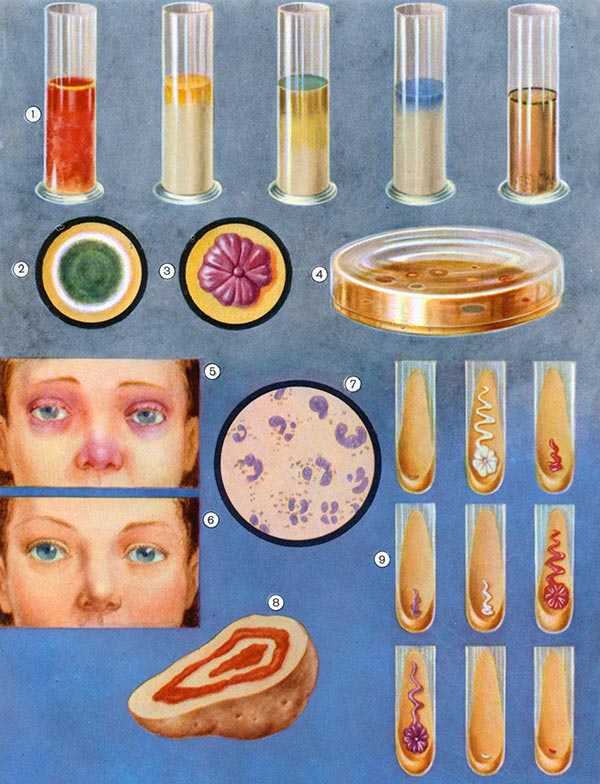
1 - “Pigmented” microbes that release brightly colored substances into a liquid (in this case, into milk); 2,3 - colonies of pigment microbes under a microscope; 4 - colonies of bacteria and fungi on the surface of nutrient jelly in a Petri dish; 5 - pathogenic bacteria caused inflammation of the face, especially the eyes; 6 - the same person after treatment with penicillin; 7 - white blood cells absorb bacteria that have entered the animal's body and destroy them; 8 - red colonies of bacteria grown on boiled potatoes. Superstitious people believed that such spots are the "blood of Christ." Therefore, the bacterium that forms such blood-red colonies is called the "wand of wonderful blood"; 9 - among the microbes there are heat-loving and cold-loving. The development of these microbes at a temperature of + 10 ° - the upper row, at a temperature of + 25 ° - the middle row and at a temperature of + 55 ° - the lower row. In the test tubes on the left are heat-loving microbes, stained purple. In the middle vertical row - cold-loving microbes, painted white. In the test tubes on the right are red-colored microbes growing at medium temperatures.
Thus, the microbes that inhabit the gut can be harmful, but they can also be beneficial. The stay of bacteria in the veins, arteries or other closed internal cavities of the human or animal body is certainly harmful.
Pathogenic microbes have adapted to exist in living tissue. Having penetrated the body, they begin to multiply there. This is how an infectious disease occurs.
If a disease that is transmitted from one person to another causes many people to get sick, then it is already an epidemic. Mass infectious diseases among animals are called epizootics, and among plants - epiphytoties.
Epizootics also affect fish. Herring, salmon are sick with plague, perches with typhus, carps with smallpox, etc. In 1932, the shores of Leningrad ponds were littered with the corpses of frogs that died from an epidemic epizootic. In 1914-1918. A plague of crayfish raged throughout Europe. To stop the infection, Finland even passed a law prohibiting the transport of live crayfish. All nets and gear were disinfected, and yet in Europe only a small part of the crayfish survived in those years. Diseases of fish, crayfish, frogs, although they bear the terrifying names "plague", "smallpox", "typhus", have nothing to do with plague, smallpox and typhoid diseases of humans and therefore are not dangerous for humans.
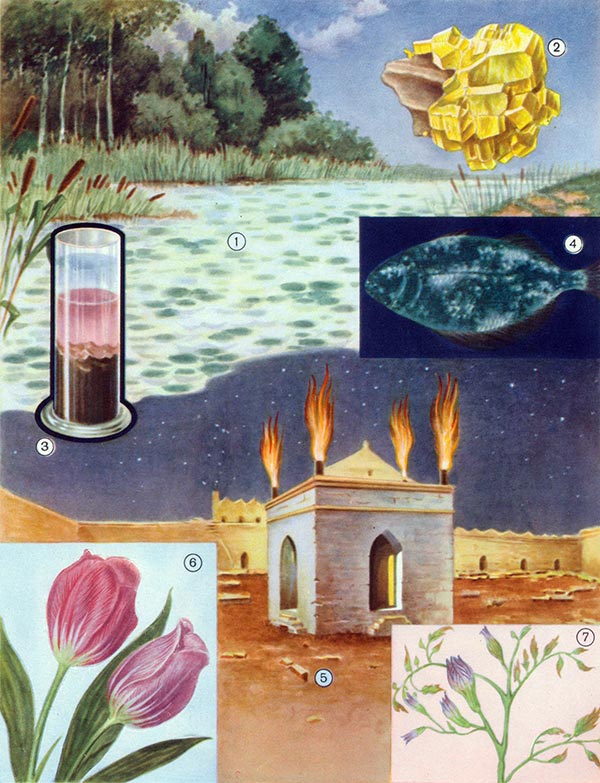
1 - the milky color of the water in this reservoir is caused by sulfur particles suspended in it. Hydrogen sulfide is released from the bottom of the reservoir. Sulfur bacteria oxidize it and turn it into sulfur; 2 - a crystal of mineral sulfur, it arose from hydrogen sulfide with the help of sulfur bacteria; 3 - during the decomposition of organic substances without air access, as in this vessel, black silt forms at the bottom of reservoirs; 4 - this fish glows because a huge number of microbes have settled on its skin, they oxidize special substances, and they glow; 5 - "eternal fires" on the roof of the temple of fire worshipers. Combustible gas flows from cracks in the earth through pipes to the roof. It is formed in the earth by microbes during the decomposition of oil and other organic substances; 6 - for many years it was believed that a tulip with variegated petals is a special variety. It is now known that the colorful petals of a tulip are the result of a viral disease. On the left - a healthy flower, on the right - a sick one; 7 - the top of a tomato plant affected by a severe viral disease - stolbur.
Any contagious disease occurs only if its pathogen has entered the body in a significant amount. If less than 10,000 anthrax bacilli enter the bloodstream of a sheep, the sheep will not get sick. A bee becomes infected with American foulbrood if at least 10,000,000 spores of the causative agent of this disease penetrate into it.
With such intestinal diseases as cholera, dysentery, typhoid fever, a person becomes infected not only directly from the sick person. The causative agents of these diseases can get from a sick person in one way or another into water or food. A healthy person, by consuming this water or food, unwittingly infects himself. Therefore, strict medical supervision of water and food products is carried out in our country.
Pathogenic microbes can get into the water along with sewage. Some types of microbes - typhoid bacillus, vibrio cholerae - having got into flowing water with sewage, float downstream and infect other areas. The germ of typhoid fever can survive in contaminated water for 10 days, and Vibrio cholerae even longer. The dirtier the water, the more microbes it contains. Away from populated areas, the number of microbes in the water is significantly reduced. In clean water, they do not multiply so quickly, but in places lit by the sun, they die.
Sunlight has a detrimental effect on many microorganisms and especially on bacteria. In clear water, the sun's rays penetrate deep and even there they kill them. At waterworks, to purify water, they send it to sedimentation tanks and then pass it through filters consisting of pebbles and sand. To destroy microbes, water is chlorinated, that is, it is exposed to chlorine gas.
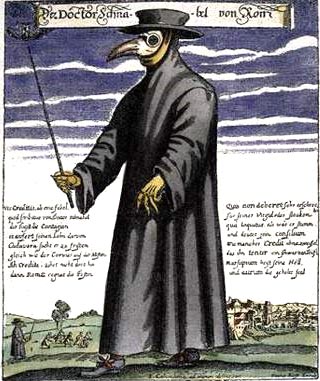
In the laboratories of waterworks, microbiologists monitor the water daily. The number of microbes in water after its special treatment is sharply reduced. So, for example, a study of water in one of these laboratories showed that there were 5639 bacteria in a cubic millimeter of river water; after passing the water through the sump, 138 bacteria were found in the same volume, and after filtration, only 17 bacteria.
Wells deliver a lot of worries to sanitary doctors. Doctors make sure that wells are not built near sewage dumps, latrines, barnyards. Pathogenic microbes that cause disease in humans or animals can enter wells through the soil. Rainwater washes away sewage, seeps into the soil and brings microbes into unsanitary wells.
In the soil, Vibrio cholerae can persist for about 25 days, and typhoid bacillus - up to 3 months. Anthrax bacillus spores do not die in the soil for years. Once in favorable conditions, the spore quickly turns into a viable bacillus.
One of the most poisonous microbes - the causative agent of tetanus - sometimes nests in fertilized soil. If several tetanus bacilli get into a wound or scratch along with contamination, then a person faces a painful death. Only a timely tetanus toxoid vaccination can save him.
Many soil microbes are very harmful to plants. In some European countries, an average of 10% of the bread harvest, 20% of grapes and 25% of potatoes are lost annually from pathogenic microbes.
In winter, frost does not destroy microbes. Many of them safely overwinter in the soil, in plants.
With the onset of heat, young plants reaching for the sun are attacked by billions of pathogenic bacteria and fungi that survived the winter in the soil. To destroy them, it is necessary to treat the seeds with various poisons, to use mass pollination of crops with poisons from aircraft.
So, air, soil and water can become sources of mass diseases of humans, animals and plants. Many insects also take part in the spread of some contagious diseases. The malarial mosquito transmits malaria, the body louse transmits typhus. In plagued areas, a flea is a messenger of death. Plague bacteria can live in the body of a flea for up to 300 days. When such a flea bites, plague sticks penetrate into the blood of a person. Taiga encephalitis is carried by ticks. People, birds (siskins, carduelis, finches, sparrows), wolves, hedgehogs, mice and many other animals get sick with it. Many diseases are transmitted to humans through animals. In areas where livestock is sick with tuberculosis or brucellosis, the causative agents of these diseases can spread to people through raw milk.
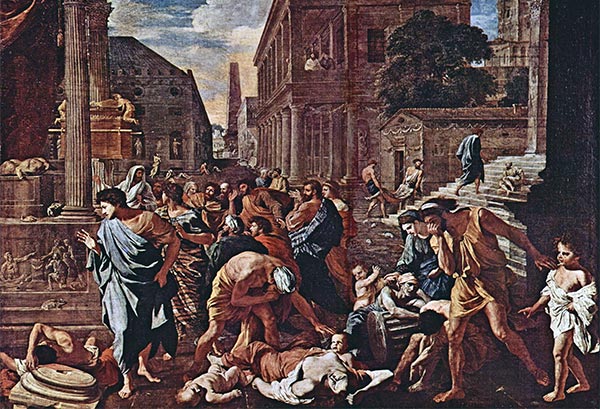
Infectious diseases are often spread through various household items. During the imperialist war of 1914-1918. merchants bought up the skins of fallen cattle at a cheap price. Short fur coats for the army were made from these skins. Some of the skins were from livestock that had died from anthrax. As a result, some soldiers fell ill with anthrax. The person himself can unwittingly take part in the spread of contagious diseases. A patient with measles, scarlet fever, diphtheria, tuberculosis, influenza, at the slightest negligence, becomes a spreader of the disease, releasing its pathogens when coughing or sneezing.
You can get infected from a healthy person. It happens like this: a person was ill with typhoid fever, recovered, but typhoid bacteria still remained somewhere in his body. From time to time they stand out, and a healthy person becomes an unwitting sower of infection - a bacillus carrier. Very often, an infectious disease does not appear immediately. It will take several days, and sometimes weeks, until the disease becomes apparent. In this incubation (hidden) period, the sick person can also become a source of infection.
In the history of human society, there have been many epidemics of plague, leprosy, cholera, typhus, and smallpox. From such an epidemic, almost the entire population of the country sometimes died out.
It has long been noted that people who have had the plague, smallpox, typhus, scarlet fever, measles are spared from re-infection for many years. Anyone who has recovered from the plague can care for plague patients with impunity. Science has established that special protective substances arise in the body of a person who has been ill - immunity is formed, that is, immunity, to this disease.
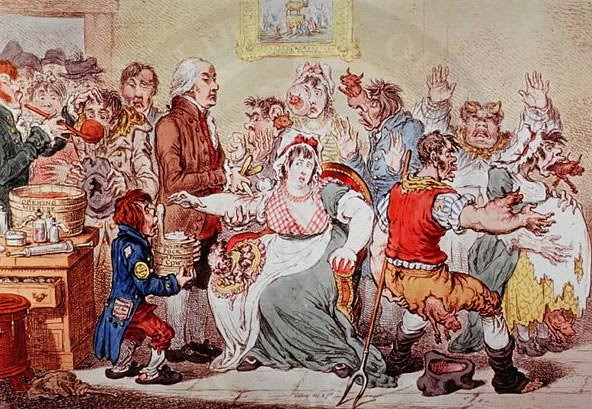
At the end of the XVIII century. in England, smallpox vaccines were vaccinated according to the method of physician Jenner. On this occasion, there were a lot of all sorts of ridiculous rumors that, allegedly, after inoculation with "cow" smallpox, horns grow in people, etc. These fears of a new method of treatment are ridiculed in a caricature of that time.
The body can be forced to produce protective substances without exposing it to disease: for this it is enough to introduce into it dead bacteria that cause the disease or live, but weakened ones. With even greater success, microbes can be used for this, the properties of which have been artificially changed. Living bacteria bring disease and even death, while those killed or transformed bring salvation. From killed or altered cultures of microbes - the causative agents of cholera, plague, typhoid fever, dysentery, tularemia - prepare wonderful protective drugs - vaccines. The method of using vaccines was developed by the French scientist Louis Pasteur.
The body acquires immunity only a few days after the vaccine is introduced into it. But with some contagious diseases, immediate help is needed. In such cases, therapeutic serum is used. It is made from the blood of an animal, in which, after the introduction of pathogenic microbes, special substances are formed - antibodies - that suppress the activity of pathogens. The use of therapeutic serums is a kind of "first aid". Serum begins to act within a few hours after its introduction into the body. For example, diphtheria microbes, actively multiplying in the throat of a sick person, can cause suffocation. A person's life is in the balance. If the anti-diphtheria serum is injected in time, he will be saved.
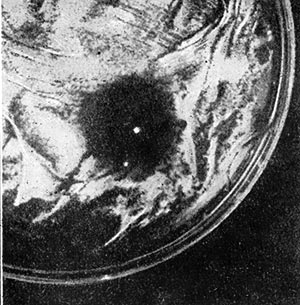
Hostile relations exist between microbes of different seeds. One of the episodes of the struggle of microbes is filmed here. The white spot on the surface of the nutrient jelly is a microbial colony that releases substances that are harmful to other microbes. Around this speck - out of death. Colonies of other microbes grew only at a respectful distance from the spot.
In 1871 - 1872. Russian scientists Polotebnov and Manassein published a study on the healing properties of molds. In 1929, the English bacteriologist Alexander Fleming isolated yellow microscopic crystals from the mycelium of a special green mold. The substance consisting of these crystals, named the green mold penicillium, was named penicillin. Penicillin causes rapid healing of festering ulcers and wounds. Penicillin is now successfully treated with pneumonia, complications after injuries, various diseases of domestic animals and even fish.
Substances that protect against invisible "enemies" are emitted not only by penicillium mold, but also by many other microbes. Many microorganisms produce substances that inhibit and even destroy harmful microbes without harming the patient's body. Such healing substances are collectively called antibiotics.
The causative agent of tuberculosis - Koch's wand caused a lot of trouble to its researchers. Penicillin has no effect on tubercle bacillus. Koch's wand is protected by a waxy layer and is inaccessible in the patient's body for many proven therapeutic agents. But here in a number of antibiotics appeared streptomycin, which kills microbes of tuberculosis, tularemia, brucellosis, synthomycin, acting against dysentery, biomycin - against many infectious diseases. A wonderful first-aid kit of antibiotics is replenished every year.
Scientists are looking for new vaccines, antibiotics and other drugs that are even more effective, and improving the methods of their application. Soviet scientists have created a sophisticated vaccine that gives immunity against several diseases.
Vaccines, antibiotics and other medications, for all their beneficial effects, are still only protective agents. Society and science are faced with the task of ensuring that diseases and epidemics disappear altogether. Our socialist country is approaching this every year.
